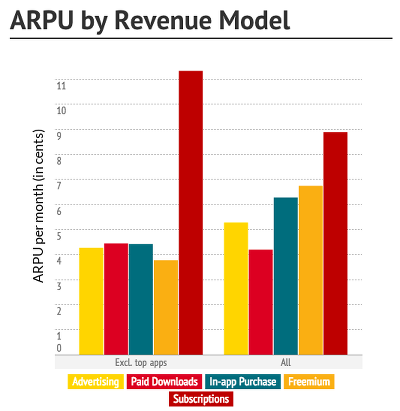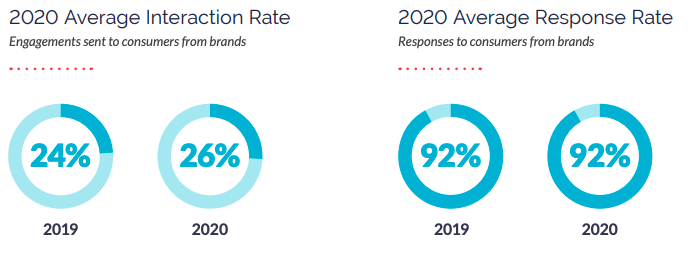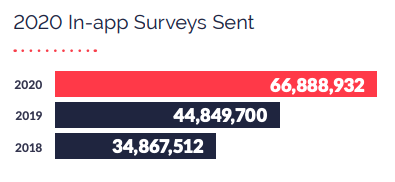The days of measuring an app’s success by downloads and ratings are long behind us. Instead, here are five meaningful mobile marketing metrics that every marketer should know like the back of their hand.
1. Average Revenue Per User (ARPU)

Average Revenue Per User is the amount of revenue each of your active customers (on average) contributes. (Read on to Engagement for a few tips on defining what “active” means in the context of your app).
Are there any meaningful benchmarks?
ARPU varies greatly by app category and revenue model, rendering comparisons rather useless. However, there have been some ballpark estimates for app categories and for various mobile revenue models:

Source: VisionMobileApart from the apps with enough value to warrant a subscription fee and the top apps that generate over $ 50k in revenue per month, ARPU is pretty constant at around $ 0.04 per active user per month (as of 2020) or $ 0.48 per active user per year.
Why does it matter?
Once you have calculated your average revenue per user, you can use it in tangent with two of the other mobile marketing metrics listed in this guide to make meaningful inferences about your app’s success:
- Used with Cost Per Loyal User (CPLU), ARPU can be used to optimally budget your mobile marketing dollars and ad spend. As a general rule of thumb, marketing dollars are well spent as long as ARPU is greater than CPLU (that is, as long as your mobile customers generate more revenue than the cost to acquire them).
- Used with Retention, ARPU can be used as a proxy for predicted lifetime value (LTV). If an engaged user generates $ 0.10 per month and is typically retained for one year, for example, you know that the predicted lifetime value of that person is $ 1.20.
2. Cost Per Install (CPI), Cost Per Loyal User (CPLU)

The Cost Per Install measures your customer acquisition costs for customers that installed your app in response to seeing an advertisement (tracking paid installs rather than organic installs).
And the derived Cost Per Loyal User metric looks at the cost of acquiring an active user (defined here as anyone who launches your app at least three times).
Are there any meaningful benchmarks?
According to ironSource’s 2021 data, the average US iOS app saw a CPI of $ 2.37; the average US Android app saw a CPLU of $ 0.44. However, as was the case with ARPU, this benchmark data should be taken with a grain of salt as both CPI and CPLU vary greatly by app store category and revenue model.
Why does it matter?
As discussed earlier, CPI (and the derived CPLU) is best used in combination with ARPU to calculate the return on investment for your marketing efforts. In order for marketing to make sense, your ARPU must be greater than your CPLU. While this may seem like a no brainer, ad spend is often not justified when it comes to mobile apps – requiring mobile marketers to really know these two metrics.
3. Engagement
Unlike the other mobile marketing metrics listed here, there is no standard definition or formula for Engagement. Engagement can only be defined within the context of the individual app and its mobile marketing strategy.
With that said, engagement is most often talked about in terms of the phenomena associated with wanting to use the mobile app longer and more frequently.
Engagement itself isn’t a metric, but there are several more tangible metrics that fall into the engagement bucket:
- Session length: How much time does a customer typically spend in your app in a single session?
- Session interval: How frequently do customers launch your app?
- App screens per session: How many parts of your app (screens) does a customer launch in a single session?
- Conversion rates for events: What percent of customers complete x action within the app?
- Interactions: What percent of customers are messaged and prompted; what percent of customers respond to a message or prompt?
- Opt-ins: How many customers sign up for additional alerts or notifications?
- Opt-outs: How many customers request fewer alerts or notifications?
Are there any meaningful benchmarks?
According to Apptentive’s 2021 Mobile App Engagement Benchmark report, the average app engaged 26% of its customers. Of those who were interacted with, 92% responded to the brand.

There was also a 50% increase in the number of surveys sent from 2019 to 2020. COVID restrictions catapulting mobile engagement was a likely driver behind the increase, along with mobile teams getting more comfortable talking with their consumers on a regular basis.

Why does it matter?
Engaged customers are the bread and butter of your mobile app’s success. Not only are engaged customers likely to bring in more referrals and give your app some love in the form of a glowing app store review, they’re likely to be more loyal and more profitable.
Paired with mobile analytic programs such as Google Analytics, engaged customers can be “cohorted” (segmented and tracked over time) to uncover trends and actionable insights into your customers’ behavior: How does engagement change over time? What actions lead to higher engagement? How long do customers stay engaged?
4. Love Percent

Unique to apps using the Apptentive Love Dialog, this metric starts with showing your mobile customers a one-question in-app survey: “Do you love this app?”

Customers have three response options: to say “yes,” to say “no,” or to dismiss the prompt. The Love Ratio is the percentage of customers polled who respond “yes” rather than either of the other two options.
Are there any meaningful benchmarks?
In 2020, 93% of all consumers who were prompted by a Love Dialog responded “Yes” or “No” rather than closing out of the prompt. On iOS, the number was even higher at 97%, compared to 84% of consumers on Android. The Love Dialog garners such high response rates primarily because of its simplicity. People are willing to answer short, simple questions and share feedback when they’re proactively asked for it at the right mobile moment.

Let’s focus on the people who responded “Yes.” In 2020, 65% of consumers prompted responded that “Yes,” they loved the brand. These quick, positive responses are a great way for brands to take a regular emotional pulse from their consumers, without asking them to leave the app for feedback or take another step away from their intended use of the app. They’re also a much better indicator of consumer happiness and potential lifetime value than lagging metrics like NPS.
Why does it matter?
The Love Percent is the simplest and most accurate way of measuring the overall customer experience. By requiring very minimal work from the prompted customer, this prompt sees virtually no opt-out, allowing you to hear from a large sample of your active customers in a short period of time.
Compare these results to your app store ratings (typically received from less than 0.05% of your customers and biased by those who have an extreme opinion of your app one way or the other—and thus more likely to take the time to fill out a review), and it’s clear that the Love Percent provides a much more representative indicator of your customer experience.
The Love Percent is also a metric that can be tracked over time and over version history to gauge how incremental updates to the app impact the customer’s experience or used as a segmentation tool to message fans and critics in a different manner.
5. Retention

Retention is a measurement of customer churn: How many customers continue to actively use your app after one week? One month? One year?
Again, the calculation of this metric is dependent on your unique app and mobile marketing strategy. Before calculating, you need to set the criteria for what a retained customer looks like. Is it anyone who launched your app in the past 30 days, or someone who uses your app every single day?
Are there any meaningful benchmarks?
How brands define “successful” retention is extremely dependent on the length of time measured. Many mobile teams focus on short-term, 30-day retention as their primary success metric. Fewer focus on 90-day retention, and very few prioritize annual retention. However, you need to look at all three metrics—especially the longer term—in order to understand how retention impacts customer sentiment and your product roadmap.
For 2021, here are the three primary app retention benchmarks to aim for.

Why does it matter?
Knowing your retention gives you a much better indication of your app’s success and current customer-base. Your app might have 100,000 downloads, but how many of these people are actually active?
With continually increasing CPIs and CPLUs, mobile marketers can also save significantly by switching gears from acquisition to retention while driving the same growth. (Read more on the benefits of retention marketing.)
Put these mobile marketing metrics to work
Understanding the five most important mobile marketing metrics gives you control over five incredibly powerful levers for increasing your app revenue. You can now:
- Increase revenue by providing more value to each customer, thereby increasing the ARPU.
- Increase profits by decreasing Cost Per Loyal User by designing more targeted and more effective marketing campaigns.
- Increase revenue by engaging more customers, thereby increasing your monthly active users.
- Increase revenue by creating an app customers love, with a higher Love Percent for each update.
- Increase profits by designing your marketing strategies around retention instead of acquisition, and use your retention as a trust signal around how well your brand knows its customers.
Digital & Social Articles on Business 2 Community
(70)




